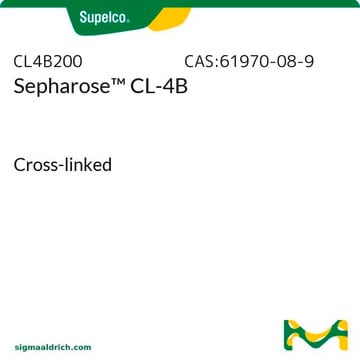C4419
Liquid chromatography columns
PTFE, Non-jacketed, bed volume 147 mL, I.D. × L 2.5 cm × 30 cm
Zaloguj sięWyświetlanie cen organizacyjnych i kontraktowych
About This Item
Kod UNSPSC:
12000000
NACRES:
SB.52
Polecane produkty
klasa czystości
for chromatography
metody
LPLC: suitable
śr. wewn. × dł.
2.5 cm × 30 cm
objętość złoża
147 mL
Szukasz podobnych produktów? Odwiedź Przewodnik dotyczący porównywania produktów
Powiązane kategorie
Opis ogólny
All of the columns listed below are constructed of borosilicate glass and are rated at a maximum pressure of 15psi (1 bar). Five configurations are available:
A - Luer-Lock, Non Jacketed: Fixed polypropylene end caps, polyethylene bed supports, Luer-Lock inlet and outlet fittings.
B - Luer-Lock, Jacketed: Same as A (above), with a borosilicate glass jacket surrounding the column body for temperature control.
C - Open-ended: Fixed polypropylene ends (outside of tube only), without jacket or end fittings. Requires 2 flow adapters.
D - PTFE, non-jacketed: Threaded ends, removable PTFE fittings with shielded O-ring seals, 20 μm polyethylene bed supports, and 1/4-28 threaded tubing connections. Solvents contact only PTFE and borosilicate glass.
E - PTFE, jacketed: Same as D (above), with an acrylic jacket surrounding the column body for temperature control.
A - Luer-Lock, Non Jacketed: Fixed polypropylene end caps, polyethylene bed supports, Luer-Lock inlet and outlet fittings.
B - Luer-Lock, Jacketed: Same as A (above), with a borosilicate glass jacket surrounding the column body for temperature control.
C - Open-ended: Fixed polypropylene ends (outside of tube only), without jacket or end fittings. Requires 2 flow adapters.
D - PTFE, non-jacketed: Threaded ends, removable PTFE fittings with shielded O-ring seals, 20 μm polyethylene bed supports, and 1/4-28 threaded tubing connections. Solvents contact only PTFE and borosilicate glass.
E - PTFE, jacketed: Same as D (above), with an acrylic jacket surrounding the column body for temperature control.
Certyfikaty analizy (CoA)
Poszukaj Certyfikaty analizy (CoA), wpisując numer partii/serii produktów. Numery serii i partii można znaleźć na etykiecie produktu po słowach „seria” lub „partia”.
Masz już ten produkt?
Dokumenty związane z niedawno zakupionymi produktami zostały zamieszczone w Bibliotece dokumentów.
Nasz zespół naukowców ma doświadczenie we wszystkich obszarach badań, w tym w naukach przyrodniczych, materiałoznawstwie, syntezie chemicznej, chromatografii, analityce i wielu innych dziedzinach.
Skontaktuj się z zespołem ds. pomocy technicznej




